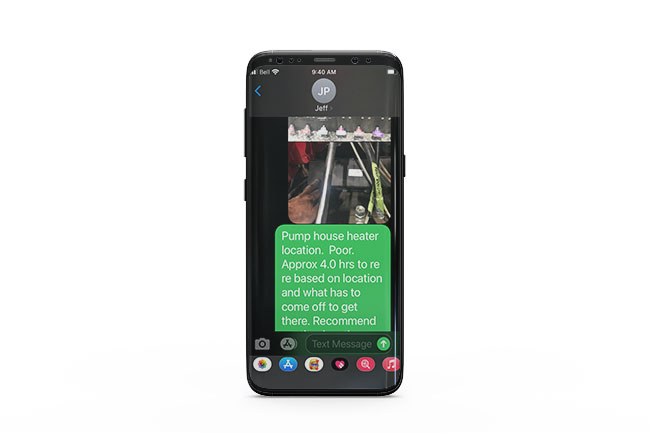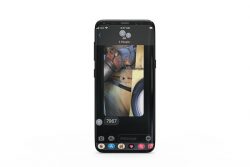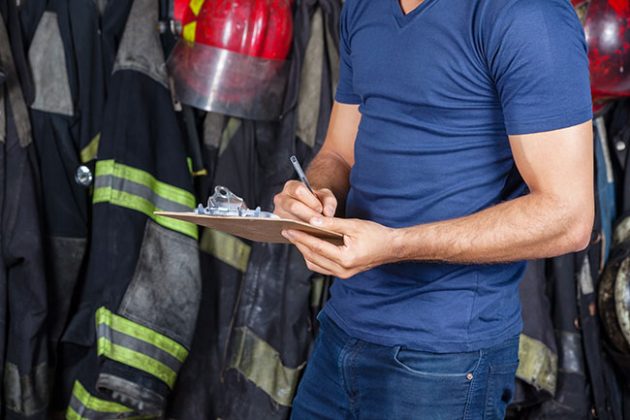
Features
Tech Talk: Truck checks, warranty work and repairs go virtual
November 2, 2020
By Chris Dennis
 My crew sends me text messages looking for help and direction and I can communicate with an OEM dealer over warranty approval. Smartphones are just one of the tools in our virtual suite. Photo credit: Chris Dennis
My crew sends me text messages looking for help and direction and I can communicate with an OEM dealer over warranty approval. Smartphones are just one of the tools in our virtual suite. Photo credit: Chris Dennis
With everything going virtual and at a distance, I decided to write about virtual truck checks, virtual warranty approval and virtual communication in the apparatus repair division. Be it a new build or even from one fire station to the chief’s office or to a dedicated mechanical division, how might that communication look? Well, I have some ideas. This type of show and tell has been done before. It is really popular in the automotive industry.
I’m an old school technician. Like all of us, I’ve had to change to stay current. I moved from the military style walkie-talkie phone to a flip-phone to a Blackberry and now an iPhone. Imagine texting now on a flip-phone? Remember three letters of the alphabet on one numeric key? Just spelling c-a-t took a while. Now we don’t even have to push a button. We ask the phone to call or we voice to text or email.
Now, COVID-19 has changed the way we do business. Companies have had to close permanently because their jobs are people-oriented customer service. Ours is also people-oriented customer service, but in a different way. Truck checks at the station level is the first line of preventive maintenance. Every one of us has some kind of smart device on us every day. If your station does have WiFi, wonderful. If it does not, each truck or station has a tablet or cell phone as part of the station kit, and that’s perfect too. Let’s proceed based on that solution.
Due to social distancing and health regulations for multiple people in one place, let’s keep it simple. Let’s take the phone with us on the truck check. As we conduct the check, we are taking pictures of things we are unsure of. We are taking videos of things that are maybe not the same today as they were yesterday. Let’s take that video and make it live via whatever means of media you are using to communicate, whether its Skype, Zoom, WhatsApp or FaceTime. Whoever has been put in charge of the fleet can actually walk through the check with the firefighter without the being there. Provide close-ups of what is actually happening instead of a written explanation of a deficiency. This means nothing gets lost in translation as well as sets a time stamp for an actual truck check. We have had this technology for some time but in a lot of cases felt it was not required. Have you ever taken your car into the dealer or gone to the grocery store or restaurant or were shown what was on the menu or what part of your car needs fixing on a tablet? If you have you have already experienced it, you can take this and apply it to your apparatus fleet. Work with this idea and fine tune it to how you do truck checks. Use it to do truck final inspections from wherever you are. We all know part of the job is touching and feeling. This too we all hope will be somewhat of the norm again. However, mark my words, we will be doing more things virtually in the electronic age. This makes me think an electronic engineer might have been great career. Nah! The fire service is for me; for us.
 In my division, all the techs have laptops. They are all tough books and now we are moving to tablets. With these laptops, they can now check vehicle history and create their own work orders, create stories to add to open work orders. The laptop’s purpose as a shop tool since covid is being used a lot more.
In my division, all the techs have laptops. They are all tough books and now we are moving to tablets. With these laptops, they can now check vehicle history and create their own work orders, create stories to add to open work orders. The laptop’s purpose as a shop tool since covid is being used a lot more.
Social distancing while communicating in each station via electronic solutions has made accountability more of a reality, but more so a means of communication without losing details by recording through pictures, video or text. In conjunction with the telephone, emails are sent to all daily with direction and a schedule for that day. As we all know, this can change in a moment. We have WiFi in the building and the use of Google and YouTube has also assisted with repairs and troubleshooting. In some cases, as Facebook users, there are fire truck repair groups that share their findings and repairs daily. This avenue also allows the user to send out questions on things and share what we have come up against and the solution to fix it. The Vaughn Fire and Rescue Service (VFRS) techs have gone one step further. Because we have WiFi, they use their personal cellphones to send both still pictures as well as videos to whoever requests them. For example, let’s say you have a newer rig and you feel the failure is warrantable. In the past you would go through a process. The tech or firefighter in charge of overseeing the repair would take the information to the shop supervisor or whoever was in charge with the description of what was wrong, what happened and what is needed to repair. We call this the complaint cause correction. With this information you would then contact the next in command or be directed to perform the next steps yourself. That means contacting the selling dealer. Odds are if it’s too technical you will have to wait until they contact the apparatus or chassis builder (OEM) to describe the repair. This can take minutes or days depending on the truck OEM builder and where they are located in the world. Let’s say the first response back you got from the selling dealer was asking for a better description of the failed part and why. For those of you that have departments without the luxury of spare apparatus then for every question asked without immediate answer, the truck sits parked.
Did you know that even if you do not have a dedicated repair facility like we do and you work with the city or municipal garage or even an independent fire truck repair facility or shop, you can still apply for warranty on anything that fails within the warranty guidelines of your apparatus purchase? With virtual or electronic technology this can be achieved. If at any time the manufacturer that built your truck, be it custom or commercial, tells you that the part is not covered by the builder and you have to go to the manufacturer, you do not need to settle for that answer. Consider personal auto purchases. You buy a Ford, Chevrolet or foreign make new from the dealer. You take it back to the dealer for warranty. You did not buy the part the dealer put on from an outside vendor — they did. The dealer can go after that vendor. For example’s sake, let’s say the part involves cracked welds on a meritor axle housing. It was spec or came as original equipment on your truck and it needs to be replaced. You call the fire truck sales company and they tell you the fire truck builder did not make that part so you must deal with part maker. Do not let that happen. The truck was built by the vendor you purchased it through. The fire truck sales company represents the builder. The builder must support the products they put on, unless in your build contract it states differently, of course. Pay attention to that. The builder can go to the vendor. All this stands true as long as the part is also well within its warranty period. If it’s out, still, keep trying.

Will paper notes become a thing of the past? Photo credit: Adobe Stock – Tyler Olsen
There is a tool I use called goodwill split. You purchased from the sales company and they represent the fire truck builder. You have been buying trucks from this sales force for some time and have a good business rapport. The selling dealer should also stand behind what they sell and should go to battle for you in all cases. The dealer we have been with has done this on many occasions with success. If you find yourself working one on one with the fire truck builder then nothing gets lost in translation. The suggestion is the part has failed. It has failed due to defect not neglect, but unfortunately is no longer covered. As a long time purchaser of this product and from the same dealer, if you have a purchasing agreement or are in good standing the goodwill split will look like this: The dealer pay a percentage, the fire department pays a percentage and vendor covers a percentage. A three-way split. Negotiations are better than frustrations. This way, the fire department is not paying entirely for something that really should have never failed this early.
Now comes the virtual part for warranty items. Take pictures of VIN mileage hours and the truck build number. Take pictures of the failed part and if a model or part number is visible, capture that too. Putting this all together in an email is best for record keeping. Send that or a text message to the selling dealer. The odds are if they are not in the office they will see your email on their phone and be able to respond quickly. I can only speak for the parts and dealers I work with and they are all excellent in returning emails quickly when it comes to warranty or truck-down concerns. If you feel you can get answers from the OEM and you have those contacts great. However, we are finding it better to go through the selling dealer unless a technical question needs to be addressed. The selling dealer will send pictures and your email description of complaint cause and correction. You should be cc’d on that. If any questions come back from OEM you can answer them right away. Very little time is lost. The dealer may ask for a video. We had a part that had failed. It was a structural component and very difficult for the OEM to understand exactly what we were seeing. With the help of a smartphone tablet or iPhone you can virtually and in real time through whatever solution you may have and show the vendor what you are seeing, describe this as you go. The correction can be discussed and completed with the fire truck builder almost in the building.
With covid and social distancing even within our own departments, the age of internet-based communications now make things even easier. It might take a bit to get warmed up to the idea but it works. If you do not have that mechanical bone in your body, but you know what you are seeing does not look right or it’s not right the description you give, that is now a show and tell virtually. The OEM can take this visual and determine a course of repair or correction.
The age of working at home for a lot in the fire service is happening for lots of reasons. It keeps people safe, it helps to prevent the possible spread and keeps our staff healthy and at the ready. We still, of course, must have people in the workplace but if the workforce happens to be infected somehow and staff has been working from home we have an alternate. You can’t perform hands-on duties though from home, which includes apparatus mechanical divisions. Here, we must have boots on the ground. Believe me if we could repair things from home, we too would be separated for safety.
Let’s discuss covid, not in a sense of what it is and what it has done, but what we can do as fire apparatus repair techs to make it simple and socially distance at the same time.
I am going to speak now as a department that may not have a dedicated repair staff on duty but depend on outside sources. You can still apply this if you an onsite repair apparatus division though such as we do at VFRS. Work with what you have presently. There is no cost involved other than data you may have on your smart device. If WiFi is available use that, if not you may want to look into this as a tool in your budget next year for repair.
Say you are (or you are) the officer or firefighter in charge of fleet repair. The repair shop or municipal garage calls you to say “Hey I need a part to fix this and I’m unsure where to get it.” For random example, let’s say the part is a Cummins engine part as simple as a filter housing. It’s cracked, it’s out of warranty and it’s sucking air. This will not allow the truck to start. In some cases as the person looking after the fleet, you might say to the repair tech “wait you lost me at hey…” My rig is at your facility now. You are the qualified person who can fix it, call me with cause and correction and a possible dollar figure or timeline, and it will be down until you, the repair tech, has it done. Don’t want for this to sound tough, but in most cases that is what is expected. Let’s take it one step further. You do know what the repair tech is talking about. You have asked questions and he tells you Cummins does not recognize this as a Cummins part and it must be a part added onto the truck when it was built. Very possible. Let’s set this up so when the tech reaches out to you he or she has all the truck info at the ready. They would love to invite you to come see for yourself but health concerns must be respected. You cannot make it. The invite now is a virtual call and you can now see exactly what they are seeing. Your plan of attack will also consist of pictures you feel will be needed or a small video of what is needed from the off-site repair tech to you so you can forward that electronically and quickly to the selling dealer or direct to the OEM truck builder, who can communicate electronically from wherever they are. The OEM can see this filter housing, confirm it is an OEM builder part or even give you a part number to buy it locally, possibly at Cummins. This can be all done from a remote office if need be.
Covid is truly awful, but it has brought us together closer as a family and as a business. For some businesses it’s been a total loss and for others the flood gates have opened. For first responders it’s a new way of doing business and living with our families. These are all lessons learned. The reality is we have to change — it’s not a matter of if, it’s when. Be proactive, use what you have in front of you, be safe, be healthy and virtually be switched on. It will make things easier and as time goes on get more of the creative juices flowing in the maintenance aspect of the fire fight.
Remember my friends, rubber side down. Be safe, be healthy and as Spock would say, “Live long and prosper.”
Chris Dennis is the chief mechanical officer for Vaughan Fire & Rescue Service in Ontario. He can be reached at Chris.Dennis@vaughan.ca.
Print this page